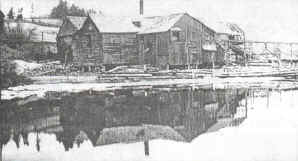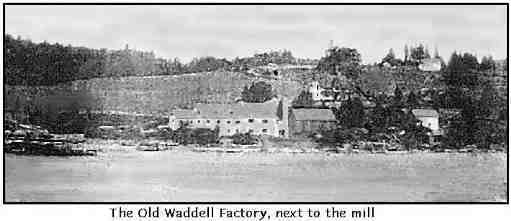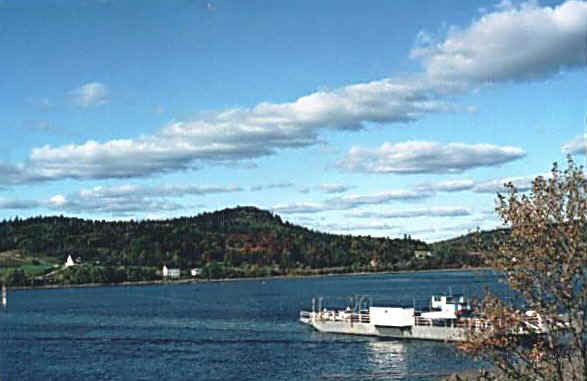|
 From
a small coastal town in Scotland, a handsome young man with adventure in
his heart and a glint of humor in his eyes, headed for the new World
across the great ocean aboard a schooner that was assigned the task of
finding masts for the King's Navy. From
a small coastal town in Scotland, a handsome young man with adventure in
his heart and a glint of humor in his eyes, headed for the new World
across the great ocean aboard a schooner that was assigned the task of
finding masts for the King's Navy.
James Waddell was born in Lesmahagow,
Lanarkshire, Scotland in the year 1789, the seventh child of John Waddell
and his wife, Jean Thomson. He left Scotland with a very little capital of
his own, but a dream of finding a new life and opportunities in North
America. James arrived in New Brunswick in the year 1819. At that
time, New Brunswick under the guidance of the colonizing loyalists, and
was gaining attention as a source of lumber.
The value of its forests was the utmost
importance and the cutting of white pine to be used as masts for the Royal
Navy was a thriving industry. Fertile farms had been carved out on the
banks of its broad rivers and orchards had been planted.
Upon reaching Saint John, the young
Waddell hired an Indian guide and went scouting in a birch bark canoe on
the St. John and Kennebecasis Rivers. He was looking for timber stands
suitable for making masts for the King's Navy. Being an astute business
man, when he came upon Reed's point on the Kennebecasis River, James
recognized that lumber was a prosperous and growing industry. Land was
available to settlers for a nominal fee, so he purchased a tremendous
parcel of land there. Having established a foothold in the new land James
returned to Scotland to fetch his new wife, Margaret Brodie, and bring her
to New Brunswick where they began to carve their new life.
Now, it seems that James had two children
by a previous marriage, a boy and a girl. They had been born in
Scotland before his first trip to Canada, and were left behind to be
raised by his father. It appears from old letters that the mother of these
children died shortly after, the second one was born. Little is
known of the son, but the daughter, whose name was Ann, wrote to her
father in 1839 asking if she could come to Canada to join him. She
was 19 at this time and her grandfather, James’ father,
was no longer living. There is no record of her ever coming to
Canada. She married a man named
Thomas Martin in Bigger, Scotland.

In 1821, James Waddell built his first mill
at Reed’s Point. The following year, he moved the mill to a spot beside
the river so ships might have easier access to the lumber. It was
run by a water wheel, 30 feet in diameter, and the water that powered it
came from a lake about a mile and a half inland from Kennebecasis River.
He named this water source Waddell Lake. The Wheel was used to drive
the gang saws in the mill. It was beside the mill that James Waddell
built his first home.
For the next 15 years, the mill prospered
and grew, as did the family of James and Margaret Waddell. Their
first child born at Reed’s Point was a daughter Susanna, born in 1821.
Five years later, in 1826,
their first son, James 2nd was born. Alexander came along in 1828,
then Margaret in 1834.
Around the year 1825, James built a grist
mill, a tall, square building with a few tiny windows. Settlers came
from Moss Glen, Clifton and Kingston, bringing grain to be ground. Those
not rich enough in worldly goods such as horses and oxen, would trudge
long distances to the mill with heavy sacks of grain on their shoulders,
then make the long trek home with the coarse, dark flour from which their
wives made bread.
Grist mills, run by water power or by wind,
were essential to the early settlers. James built a factory near the mill,
a large building that was used as a mercantile and furniture shop. The
trim for many homes was made here. Some of that trim is still
evident today on the house that stands above the mill, the McCormick home
on Kennebecasis Island, and on Ilene Wetmore’s home in Clifton.
During the heyday of the lumbering
business, the woodworking factory was operated in conjunction with the
mill. The mill produced millions of board feet of lumber which went
into the making of sturdy sailing vessels, launched almost under its
shadow. They turned out lumber for doors, window frames and houses.
They made adult coffins for $7.00, while a child’s coffin went for $2.50
to $3.00. Much of the lumber used to re-build Saint John after the great
fire of 1877 came from the Waddell mill. Lumber
was exported by ship to such faraway ports as Cleveland, Dorchester, and
other points in the U.S.
A shed at the factory was used to dry the
wood. The lumber was placed vertically with gaps between the boards
to let air circulate. The dried lumber was then sold or used to
build furniture. A blacksmith shop was established on a corner near the
mill. Nails, wagon wheels, and some other of the metal used on the
arms of the first ferry to prevent the wood from wearing on its pulleys as
the cable went through, were made there. They also manufactured the big
tanks that held water to help keep the engine cool on the ferry.
After the birth of their fifth child, David
in 1835, James returned to Scotland in 1836 to purchase forge equipment to
upgrade the mill. On his return voyage, while traveling up the
Kennebecasis River on the schooner "The Jean", the ship sank.
With special permission, he was able to retrieve his precious cargo from
the sunken hull. Two more children were born to James and Margaret at
Reed’s Point. John in late 1836, and Edward in 1838.
In 1908, the driving force for the old mill
was replaced by steam and the old water wheel was abandoned. The
gang saw blades, which moved up and down, were replaced by more modern
rotary saws. This made the mill some what less picturesque, but much
more efficient. It also gave the men who worked the mill, shorter hours
and higher wages. In the early days, the workers would arise at 4 o'clock
in the morning. One would go up to the lake, open the dam and
release the water to power the mill. They worked all day for the princely
sum of one dollar.
All the lumber for the mill was cut from
James Waddell property. In his wisdom, he had given orders that no
small trees were to be felled. The order was to be carried by his
eldest son, James Waddell Jr., who took over operation of the mill
in 1845, and by his grandson, James Elphanston Waddell who took over
in 1896. This explains how the mill was able to provide its own
source of lumber for so many years.
As an indication of how financially
successful the business was, an old account book from October 1880 shows a
sum of $11,879.24 being paid on account. The book keeping was very
accurate and even with their limited education, they managed to accurately
record all transactions in their ledgers. A person buying lumber to
be shipped had to pay storage, insurance and commission to the supplier
The store stocked many types of supplies. Most purchases were paid
for by the month, some with trade. They also loaned sums of money to
those in need.
Here are some examples of the goods carried
and the price of these commodities back in the late 1800's:
Salt .................1box.............15c
Oil..............5 gallons..............25c
Flour ...............10 punds .....15c
Softwood....3loads................30c
Stockings..........1 pair..........15c
Tea.............1 pound...............30c
Hardwood........1 load..........15c
Molasses....1 gallons..............52c
Broom..............1................. 25c
Tobacco....1 pound ..............25c
Cough Medicine.1bottle........25c
Pants..........2 pairs.................25c
One could buy all of their sewing needs there as a carding machine for the
wool, settlers could have their grain ground, lumber cut, and wool carded,
all within a short distance of their homes.
A few years after James E. Waddell (James
3rd) took over the running of the mill in 1896, his son Roy St. Clair
Waddell built a second mill just up the road and ran it for many years.
Roy’s younger brother,
Lorne Kenneth Waddell, became the original mill owner after his father,
and ran it right up until May of 1950, when the mill was burned to the
ground. There was no insurance, so Lorne and his older brother,
James Eugene Waddell completely rebuilt the mill from their own resources.
Since the year 1821, the Waddell's have
owned, operated and worked in these mills, and provided work for many of
the people around Reed’s Point. And now, a fifth generation
Waddell, Donald, son of Lorne, owns and operates the Waddell mill at
Reed’s Point. Over the generations, many houses were built in the
area, with lumber from the mills. The one that still stands above
the mill is now owned by Lorne’s son Charlie Waddell.
Years ago, champion speed skater, Hugh
McCormick married Sarah Waddell, daughter of James the second. They
ran the hotel for a number of years before moving to Sussex, and later to
Saint John where they ran the 3 mile Hotel. Lorne Waddell’s third child
and only daughter, Roma, now owns the old hotel, the Willows, situated
about ½ mile from the Gondola Point Ferry. It was brought to this
spot, section by section, from the Mount Misery Road, about a quarter of a
mile down the road.
On the same section of land where the
Willows stood, the first court house was built. Across the road was
Gallows Hill, where a man named Shanks was hung. After the court house
burned, a hotel called the Glengarry and he supplied a Gondola to bring
customers across the river to the hotel. That is how Gondola Point
got its name.
James Waddell built a school directly
across from the Willows. It was also used as an Orange Hall and a Sunday
School. A teacher taught in this school for 10 cents per day per
pupil. The teacher in 1903 was Edith Cummings and her pupils were:
Pearl Belyea, Mable Coffey, Jennie F.
Coffey, John Coffey, Harry Coffey, Agnes Cronk, Genevieve Flewelling,
Harold Flewelling, Brock Flewelling, Ida Marshall, Stanley Pitt, Douglas
Pitt, Ella Pitt, J. Eugene Waddell, Jessie Waddell, John C. Waddell,
Mable Waddell, Mary S. Waddell, Effie M. Waddell, Annie Waddell,
Clyde Waddell, Roy Waddell, and Amanda Worden.
When the children of the original Waddell's
at Reeds Point married, and their sons and daughters married, new families
were welcomed into the clan -- Sterritts, Galleghers, Waltons,
Gillilands, Stewarts, Halls, Brawns, Cathlines, Archibalds, Whites and so
many more. If you were to meet today's descendants of James Waddell
and his wife, Margaret Brodie, you might notice the family skills that
have been passed down from generation to generation -- mechanic,
machinist, mill worker,
electrician, and jack of all trades and master of most of them.
Written and researched By Ann Waddell,
edited by Jim & Gerri (Waddell) Archibald, Glenna Jack With thanks to
my father Charlie Waddell, and his sister Roma Scott, to letting me dig
through old papers and pictures, without their help I would not have been
able to go as far as I have.

Hi out there cousins,
I haven't sent my history out in a while, actually
since we made the ultimate contact, what a rush that was! So I will write
this letter and save it and every once in a while resend it.. my two
friends Glenna Jack and Jim Archibald and I have finished a
book on "Waddell's from Reeds Point and Beyond" we have made it
back to the late 1600's.. I will write out the generations and if anyone
has more info on one of these ancesters write back as as we are doing a
follow up.
Our ancester is James Waddle born May 9, 1787, in
Stonebyres Ground, Lanarkshire Scotland, he married Margaret Brodie born
Dec. 14, 1794, he left behind a son and a daughter the son died early and
the daughter Ann born 1720 was raised by her grandfather, later on married
a Thomas Martin and lived her life out in Biggar Scotland, looking for any
info on her also.
James Waddell married May 30, 1713 in
Lesmahagow, Lanarkshire, Scotland, Agnes Arbuckle, their children were:
all were born in Lesmahagow
1. Janet born May 30, 1714 in Gilbank
2. John born April 13, 1718 in Hoodshill
3. Barbara born Aug. 28, 1720 in Hoodshill
4. Rachel born June 3, 1722 in Hoodshill
5. Cordelia born July 12, 1724 in Hoodshill
6. Alexander born April 17, 1726 in Hoodshill
7. Elizabeth born Feb. 23, 1729 in
Hoodshill
8. James born June 3, 1735 in Affleck
Our direct ancester from here was:
Alexander born April 17, 1726, he married
Helen Steel on July 11, 1750, their children were born also in
Lesmahagow in small village, the children were:
1. James born Dec. 7, 1752 in Nether Affleck
2. Alexander born June 28, 1754 in Taithes
3. John born Jan. 2, 1756
4. Thomas born Oct. 7, 1757 in Affleck
5. _______born Aug. 1, 1759, Nether Affleck
6. Agnes born Feb. 7, 1762, in Nether Affleck
7. Helen born Mar. 20, 1764, in Nether Affleck
8. Thomas born June 13, 1766 ""
9. Robert born April 9, 1768, ""
10. Marion born April 9, 1768 "" these two of
course were twins*
Our James grandfather was John Waddle born
Jan 2, 1756 he married March 21, 1777 a Jean Thomson born about 1759 from
the same place, John died before 1836..Their children were:
1. Alexander born April 15, 1777
2. William born Dec. 24, 1778
3. Marion born Dec. 25, 1780, it is assumed this,
John and Jean's 3rd child died as they also named their 10th child, Marion
4. Helen born July 16, 1782
5. John born Feb. 4, 1785
6. James born May 9, 1787**which is our direct
ancester**moved to New Brunswick Canada*
7. Robert born July 28, 1789
8. George born June 19, 1793, **we have made
contact with George's direct ancester Marisa Visocchi, who is my 5th
cousin, she lives about 20 km from Lesmahagow, I was quite excited to meet
her.
9. Marion born Mar. 11, 1796
I have a web page on
http://www.fortunecity.com/millenium/rover/233/waddell2.htm
if you would like to look at our story; we have met and made many
friends and relatives on our journey back.. Hope we make a new
connection and it will help all of us.
thanks
Anne Waddell |
